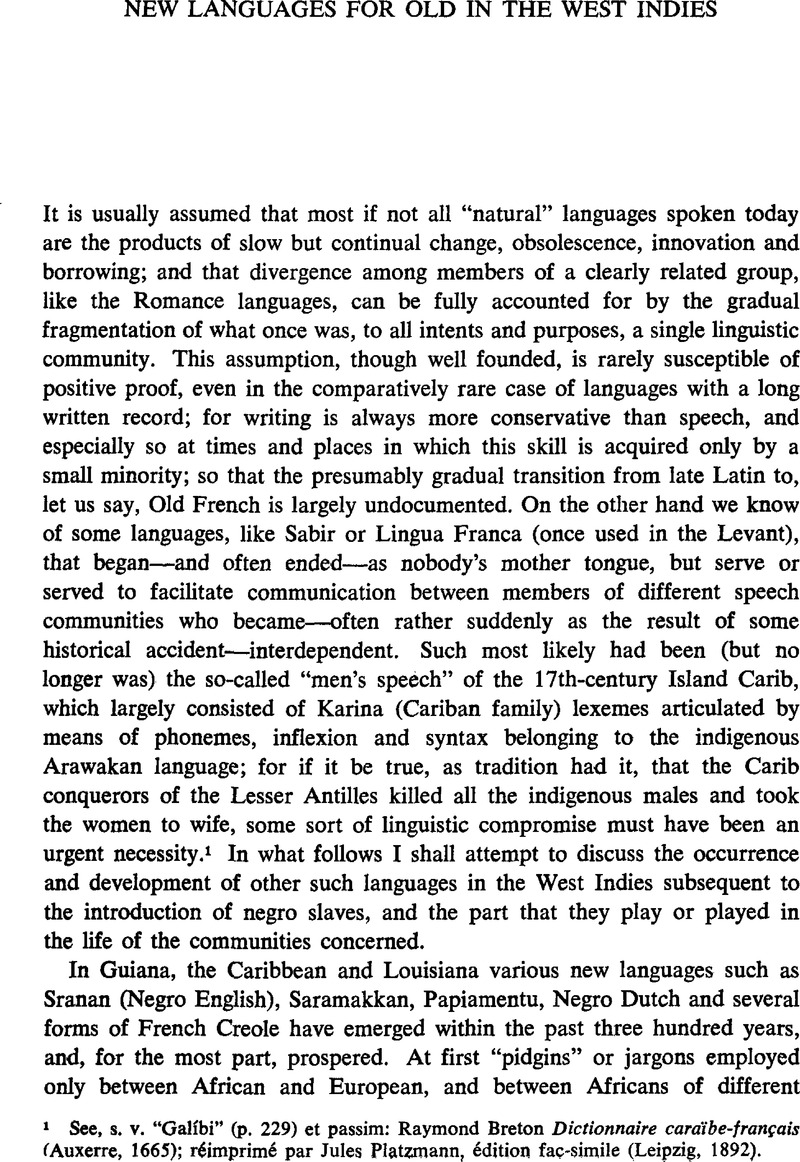Article contents
New Languages for Old in the West Indies
Published online by Cambridge University Press: 03 June 2009
Abstract

- Type
- Article Commentary
- Information
- Copyright
- Copyright © Society for the Comparative Study of Society and History 1961
References
1 See, s. v. “Galíbi” (p. 229) et passim: Breton, RaymondDictionnaire caraïbe-frangais (Auxerre, 1665)Google Scholar; rémprimé par Jules Platzmann, édition fae-simile (Leipzig, 1892).Google Scholar
2 Navarro, Tomás, “Observaciones sobre el papiamento”, NRFH, VII (1951), p. 188Google Scholar ff., and vanWijk, H. L. A., “Orígenes y evoluciOn del papiamentu”, Neophilologus, XLII (1958), p. 169 ff.CrossRefGoogle Scholar
3 Citations from Chevillard and Pelleprat are both taken from Calvert, L., “Histoire de la formation du language créole”, Martinique, 12 1944Google Scholar. The latter author himself took them from, respectively: Banbuck, C. A., Histoire politique, économique et sociale de la Martinique (Paris, 1935)Google Scholar, and Pelleprat, Pierre, Relation des missions des pp. de la Cie. de Jésus dans les isles, et dans la Terre Ferme de l' Amérique méridionale (Paris, 1656). Calvert does not say what edition of the latter he used but the spelling—evidently modernized in the case of Pelleprat, and not (or less) in that of Chevillard—is as given by him.Google Scholar
4 On p. 234 of her Du francais aux parlers creoles (Paris, 1956), Elodie Jourdain gives the text of a message sent by a Guianese Amerindian, pupil of the Jesuits, to the French Governor d'Orvilliers in 1744; and which she believed to be the oldest monument of French Creole: Anglai pran Yapok, yé méné mon pére alé, toute blang foulkan maron dans bois “(the) English have taken (the) Oyapok (post), they have carried off (the) priest, all (the) white (people) have cleared out (and) taken refuge in (the) woods”. The same message would be conveyed in the same words in the Guianese dialect of today.Google Scholar
5 See: Thompson, Robert Wallace, “A Preliminary Survey of the Spanish Dialect of Trinidad”, Orbis, VI (1957), p. 353Google Scholar ff., and Nazario, Manuel Álvarez, El arcaísmo vulgar en el espaliol de Puerto Rico (Mayagüez, Puerto Rico, 1957).Google Scholar
6 It is true that mouche manigat “very skilful” is said to have occurred also in the jargon used between Europeans and Island Caribs; and some have attributed manigat to the latter's language. Breton denies this; but if he was mistaken, these Indians must have had a peculiar sense of humour; for the most similar word in their language, manikati, means “unable or not disposed to do (something)”.
7 Whinnom, Keith, Spanish Contact Vernaculars in the Philippine Islands (Hong Kong-London, 1956). In a review of this book, in Word, 13 (1957), p. 489 ff., I have mentioned some similarities between the languages therein described and the West Indian creoles.Google Scholar
8 Calvert, L., op. cit., Martinique, 06 1944.Google Scholar
9 L. Calvert (op. et loc. cit.), citing Martineau ècles d' histoire Antillaise, says: “Les noirs sont moins nombreux en 1652, avec Pelleprat. Es tendent à l'égalité en 1658, avec Rochefort; ils sont superieurs en nombre en 1660, d' après la relation des Iles. C'est donc entre 1658 et 1660 que la population noire dèpasse la blanche pour suivre un mouvement continuellement ascendant. Elle la double en 1720, la quadruple en 1740, épque à laquelle les blancs étaient eux-mêmes cinq fois plus nombreux qu'en 1660. Le nombre des noirs augmentait sans cesse: Il atteignait 70.000 en 1763 et 90.000 en 1789.”
10 See: Vérin, Pierre, “The Rivalry of French Creole and English in the British West Indies”, De West-lndische Gids, 38 (1958), p. 163 ff.Google Scholar
11 See: UNESCO, , The Use of Vernacular Languages in Education (= Monographs on Fundamental Education, No. VII) (Paris, 1953).Google Scholar
12 Thompson, Robert Wallace, “The ‘th-Sounds’ and Genetics”, Phonetica I, 3/4 (1957).Google Scholar
13 Arciniegas, Germán, Caribbean Sea of the New World (New York, 1946), p. 213 ff.Google Scholar
14 Pāce Professor Robert Le Page formerly of the UCWI (and others), who holds that “broad Jamaican Creole stands in much the same relationship to English as does Haitian Creole to French” (personal communication). The clue to what I regard as an essential difference is the qualification, “broad”. So far as I could ascertain, there is a continuous gradation in the speech of Jamaicans—such as exists within perhaps most fairly large speech communities—from the broadest dialect to the local variety of standard English; and everybody normally uses the nearest approximation to the latter with which he or she is familiar. But there is not and cannot be any such gradation from a French Creole to any dialect of French because of great differences in basic grammar; and it is always clear which language is being spoken, even though it be a variety of Creole that is full of gallicisms or a variety of French that is full of creolisms. I do not doubt that "broad" Jamaican (or Barbadian) began in a pidgin that became the mother tongue of some; but this mother tongue has evolved continuously in the direction of “normal” English, as which it should now be identified for the reasons stated above.
15 For some examples of such correspondences, see: Herskovits, Merville J., The Myth of the Negro Past (New York, 1941), p. 282.Google Scholar
16 For further details of this people's history, see the Introduction to my monograph, The Black Carib of British Honduras (= Viking Fund Publications in Anthropology. No. 17) (New York, 1951).Google Scholar
17 From: Trefossa (puëma fu), Trotfi; p. 19. Published for the Bureau of Linguistic Research in Surinam (University of Amsterdam) (Amsterdam, 1957). Arusubanja is the name of a rapid in the Surinam river; and means, literally “shakes the ribs loose”.
- 10
- Cited by




